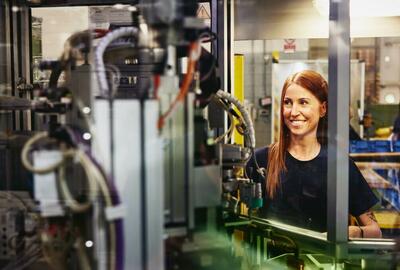Employee retention strategies are critical for manufacturing businesses. A stable workforce of trained, experienced employees is essential to maintaining productivity and ensuring your business can grow. Whether you’re transitioning through technological advancements or looking to take on new projects, having a skilled and dedicated team helps you stay competitive.
The global talent shortage has made it tough to find new talent, especially in manufacturing, but there’s one area where you have control — holding on to the skilled workers you already have. In this article, we’ll break down why employee retention strategies are essential for HR success, why keeping employees is often better than replacing them, and how you can boost your retention rates with practical tips.
employee retention 101
Employee turnover is inevitable — some people retire, relocate or change careers. However, when skilled workers leave, it can be costly in terms of both time and money. Recruiting and training new talent isn’t just expensive. It also disrupts your workflow. In an industry like manufacturing, where skilled employees are already hard to find, it makes more sense to focus on higher retention rates by improving job satisfaction and creating a supportive work environment.
Losing key employees impacts more than just your bottom line. A strong team dynamic helps maintain productivity. When top-performing employees leave, it creates a ripple effect, leading to employee burnout among remaining workers. Plus, in a competitive market, finding replacements with the same level of expertise is difficult. This makes having a strong employee retention rate essential for a successful company.
Finally, attitudes are changing across the workforce, and if you don’t actively work to retain employees, you may find yourself coming up short. For instance, a recent Randstad survey found that 46 percent of Gen Z manufacturing workers plan to quit their jobs to find better work-life balance.
how to craft a robust employee retention strategy
To create employee retention strategies that work, you first need to understand why workers leave. Researching the common reasons for turnover can give you valuable insights into your workplace culture and areas for improvement. Here are some ways to gather helpful information:
- Create an anonymous survey. Employees don’t always feel comfortable talking about work-centric issues. Anonymous surveys give workers the freedom to share their concerns without fear of judgment, helping you identify any turnover risks.
- Conduct exit interviews. Consider hiring an independent consultant to lead exit interviews. People often find it easier to speak frankly with interviewers who don’t directly represent the companies they work for.
- Speak to popular employees. Some workers become informal leaders on the warehouse or factory floor. Speak to them one-on-one to see if they can provide insight into workforce morale.
- Tackle bad managers. Keep an eye on supervisors and managers in your organization and take complaints seriously. Provide managers with leadership training and hold them accountable at every level.
- Analyze patterns. Is turnover more common in a particular department? Do specific types of employees leave more often than others? Do certain workers hold more stressful positions than others?
- Evaluate engagement. When people feel engaged and interested in their work, they stick around. Try to determine if top-performing employees feel fulfilled and enjoy their assigned tasks.
- Read between the lines. When workers who usually perform well begin to withdraw or underperform, you can safely assume they’re not happy. Talk to them about why that might be — and take them seriously if they feel burned out or dissatisfied.
want to improve employee retention?
Download our guide, ‘7 actionable strategies to boost employee retention’.
download the guide3 employee retention strategies that work
Once you’ve identified the common reasons employees leave, you can take action to improve your employee retention rate. Here are three employee retention strategies that can help you build a positive work environment and retain your best workers.
1. offer flexible scheduling
Factories changed in response to COVID-19 as workstations moved, workers sat further apart and robots took over some human roles. At some companies, additional shifts were created to accommodate social distancing. Some factories closed entirely during pandemic peaks and a select few shifted to a remote manufacturing strategy, even if with fewer workers on board.
Once things returned to “normal,” some employers reverted right back to their old practices. Employees, however, don’t want to return to the status quo. Randstad’s Workmonitor 2024 survey found that 41 percent of respondents would not accept a job without flexible working hours. Generational differences are evident in the data, with Gen Z expressing the strongest preference for flexible work arrangements.
Therefore, it may be time to consider flexible working options for production facilities, including flex scheduling and shift swapping. For example, compressed schedules — where people work three or four longer shifts and then take several days off — are a potential alternative to traditional five-day weeks.
With the right oversight and optimal platforms in place, flexible scheduling works surprisingly well. Even better, employees like flexible schedules and feel more productive, less stressed and more satisfied with their jobs. In short, they’re more likely to stay with their employers.
2. provide better training
People love to learn. In fact, the opportunity to learn new skills is one of the biggest draws to any new job — especially if that learning leads to promotion.
Ideally, training should begin shortly after hiring and continue throughout the employee’s tenure with you. Six distinct types of training exist:
- Orientation. At orientation training, you introduce your company culture, mission, values and organizational structure. As a result, new employees gain a better understanding of the corporate landscape and settle into their jobs.
- Onboarding. Your well-rounded onboarding training program represents a direct investment in retention. Onboarding covers department goals, technical aspects of the new employee’s role and much more.
- Tech skills. As artificial intelligence (AI) and automation reshape the manufacturing industry, providing ongoing training and development opportunities is crucial for attracting and retaining talent. This includes training on new technologies and processes as well as opportunities to upskill and reskill to prepare for future industry demands.
- Soft skills. Team-related skills like communication, leadership, conflict resolution and corporate ethics aren’t just for managers. To ensure a cooperative and inclusive workplace, you must show that your company values people.
- Quality control. An essential type of training in the manufacturing, logistics and automotive sectors, quality control programs ensure products meet particular standards.
- Safety. Safety training is a legal must-have in many environments. Employees learn safety policies and procedures, how to use safety equipment properly, and how to administer first aid. Industry-specific safety training topics like asbestos, construction and food safety might also apply.
By providing continuous opportunities to upskill and reskill, you improve employee job satisfaction and make it clear you’re invested in their long-term success.
3. work with an HR solutions partner
Flexible scheduling and training programs undoubtedly help improve employee retention. Another highly effective way to reduce staff turnover is to work with a talent solutions provider. After all, flexible schedules and communication courses only boost retention if applied to the right workers.
Professional staffing firms can find and recruit the right employees for your organization. Many candidates look great on the application and during interviews but then fall short after they’re hired. Recruiters have vast hiring experience — after all, they recruit for a living — and know what truly great talent looks like.
The best staffing companies have hundreds or even thousands of legitimate job seekers on file globally. When you contract with them to help you hire people, they reach out to pre-vetted workers before placing new ads. This can help save considerable time — and a lot of money. Some companies, like Randstad, continue supporting workers they help to hire — even after they’re on your books. They will also collaborate with you to provide training and assist with long-term employee retention strategies.
We transform the stress of recruitment into a golden opportunity for development and, ultimately, the retention of employees. By leaving the hiring, onboarding, training and support to us, you can focus on growth and innovation at the executive level.
get more candidates to fill your manufacturing or logistics shifts with our proven strategies
Download our guide today and learn how to go beyond CVs to find the best talent for your organization.
download the guide





